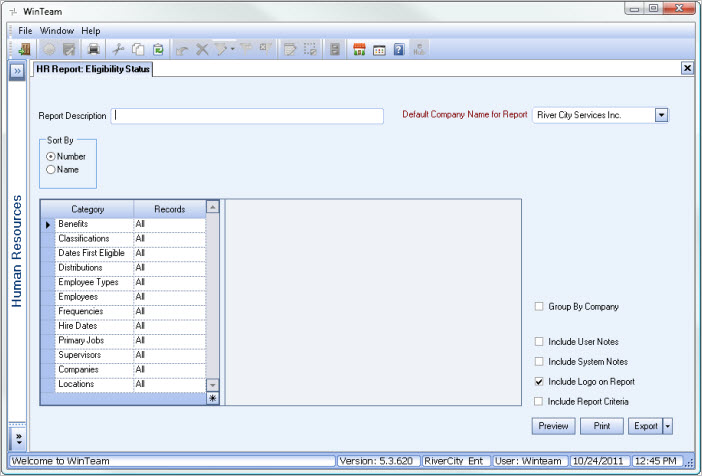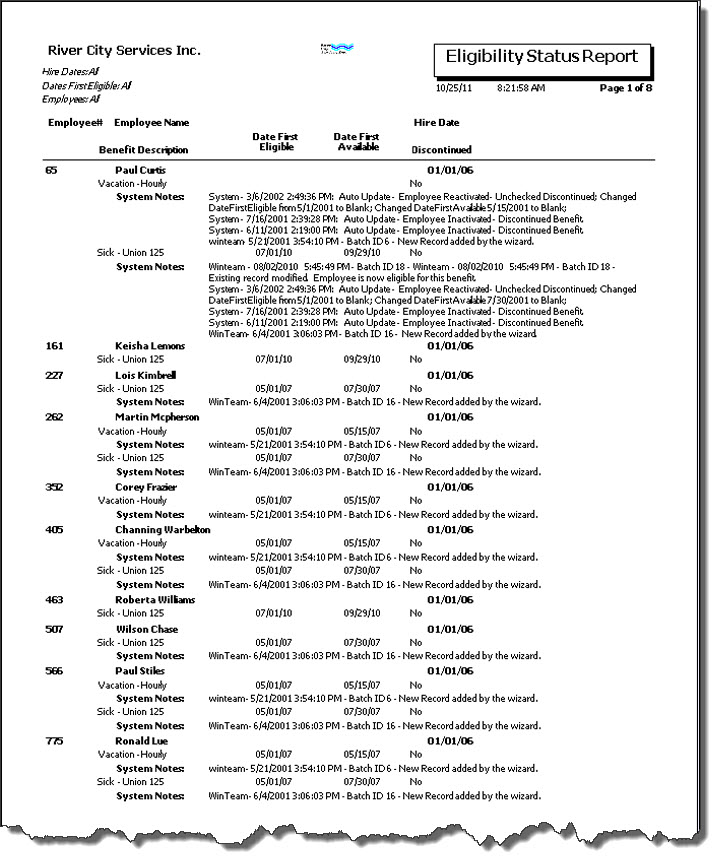Overview
The Eligibility Status report lists the Eligibility Detail records that exist in the Hourly Eligibility Status screen. Eligibility Details records are only created for Hours Accrual benefits, and do not apply to Insurance/Other benefits. Once an employee is eligible for an Hours Accrual benefit, the system considers the employee for future accruals, as long as the employee has met all other eligibility requirements.
The system includes only those records where the logged in user has a HR Benefits Read Security equal or greater than the employee security level.
The HR Report Eligibility Status screen has its own Security Group, HR Report Eligibility Status.
The HR Report Eligibility Status screen is part of the HR Reports All Benefits Security Group.
Tip: For more information see Security Groups Overview and Security Groups By Module.

Related Information
Key Functionality
Type a description to name the report. This description prints above the Report Title.
Available for Clients using the Multi-Company feature. The Default Company Name for Report is populated from the Company Setup screen. The list contains all companies you have permission to access. The default company prints on every page of the report.
If the User has permission to only one company, then just that one company will display in the list. If the User has permissions to more than one company, the list will contain all companies the User has rights to PLUS the default reporting company. For more information see Learning about WinTeam Reports.
Sort By
Use the Sort By option to sort the report data by Employee Number or Employee Name.
The default selection is to sort by Number (Employee).
Category/Records
Benefits
Use the Benefits category to select the Benefits to include on the report.
Select All to include all Benefits on the report.
Select Pick to define specific Benefits for the report. When you select Pick, the Benefits list displays. Select the check box next to each Benefit to include on the report.
Classifications
Use the Classifications category to select the Classifications to include on the report.
Select All to include all Classifications.
Select Pick to define specific Classifications for the report. When you select Pick, the Classifications list displays. Select the check box next to each Classification to include on the report.
Dates First Eligible
Use the Dates First Eligible category to filter the employees to include on the report by the date they were first eligible for Hours Accrual benefits. Changes to Dates First Eligible may be made on the Hourly Eligibility Status screen.
Select All to include all employees, regardless of the date they were first eligible.
Select Date Range to define a range of Dates First Eligible for the report. When you select Date Range, the range fields display. Type the beginning date in the From field and the ending date in the To field. The system will include in the report those employees who have a Date First Eligible that falls within this date range.
Distributions
Use the Distributions category to select the Distribution to include.
Select All to include all Distribution types.
Select Pick to define specific Distribution to include. When you select Pick, the Check Distributions add edit list displays. Select the check box next to each Check Distribution to include.
Employee Types
Use the Employee Types category to select the Employee Types to include.
Select All to include all Employee Types.
Select Pick to define specific Employee Types. When you select Pick, the Employee Types list displays. Select the check box next to each Employee Type to include.
Employees
Use the Employees category to select the Employees to include on the report.
Select All to include all Employees on the report.
Select Range to define a range of Employees for the report. Type the beginning Employee Number in the From field and the ending Employee Number in the To field.
Select Create to define your own list of Employees. When you select Create, a small grid displays to the right. Enter the Employee Numbers you want to include in the list, or use the Lookup to locate the Employee Numbers.
Select Exclude to identify records that should not be included. When you select Exclude, a small grid displays to the right. Enter the Employee Numbers you want to exclude in the list, or use the Lookup to locate the Employee Numbers.
Frequencies
Select the Frequencies to include on the report.
Select All to include all records, regardless of Frequencies.
Select Pick to define specific Frequencies for the report. When you select Pick, the Frequencies list displays. Select the check box next to each Frequency to include on the report.
Hire Dates
Use the Hire Dates category to select the Hire Dates to include on the report.
Select All to include all Hire Dates.
Select Date Range to define a range of Hire Dates for the report. When you select Date Range, the range fields display. Type the beginning date in the From field and the ending date in the To field.
Primary Jobs
Use Primary Jobs to filter the report by Primary Jobs.
Select All to include all Primary Jobs.
Select Range to define a range of Primary Jobs for the report. When you select Range, the range fields display. Type the beginning Primary Job Number in the From field and the ending Primary Job Number in the To field.
Select Pick to select the Primary Job(s) to include.
Select Create to define your own list of records. When you select Create, a small grid displays to the right. Enter the records you want to include in the list, or use the Lookup to locate the records.
Select Exclude to identify records that should not be included. When you select Exclude, a small grid displays to the right. Enter the records you want to exclude in the list, or use the Lookup to locate the records.
Supervisors
Use the Supervisors category to filter the report by Supervisors.
Select All to include all Supervisors.
Select Pick to select the Supervisor(s) to include.
Companies
The Company Pick option filters for AR Invoice and Payment records. The Companies category is available for Clients using the Multi-Company feature.
Select the Companies to include on the report.
Select All to include all companies on the report.
Select Pick to define specific Companies for the report. When you select Pick, the Companies list displays. Select the check box next to each Company to include on the report.
Note: When running reports using the Company Category/Record Pick and the company name exceeds the maximum number of characters, WinTeam will truncate the name.
Locations
The Locations category is available for Clients using the Multi-Location feature.
Use the Locations category to select the Locations to include on the report.
Select All to include all Locations on the report.
Select Pick to define specific Locations for the report. When you select Pick, the Locations list displays. Select the check box next to each Location to include on the report.
This option is available to users who have more than one company, but is not selected by default. If selected, the default company prints on the Grand Total Page and the Report Criteria page. All other pages print the applicable company name. If not selected, the default company prints on every page of the report.
Include User Notes
Select the Include User Notes check box to include the User Notes from the Hourly Eligibility Status record..
Include System Notes
Select the Include System Notes check box to print the system notes on the report.
Select this check box to print the company logo on the report. It is selected or cleared by default based on the option selected in SYS:Defaults. However, you can modify the setting on each report.
Select this check box to include a list of the report options selected for the report. The Report Criteria page includes any ranges specified and each Category/Record selection made for the report. This check box is cleared selected by default.
Preview
Click the Preview button (or use the shortcut key, ALT + V) to view the report before printing.
Click the Print button (or press ALT + P) to send the report to your default printer.
Export
Click the Export button (or press ALT + X) to export the report to a specified format. Reports may be exported to Adobe Acrobat (PDF), Excel, Comma-Separated Values (CSV), Grid View and E-mail (available for premise-based clients only).
Eligibility Status Report (including System Notes)

